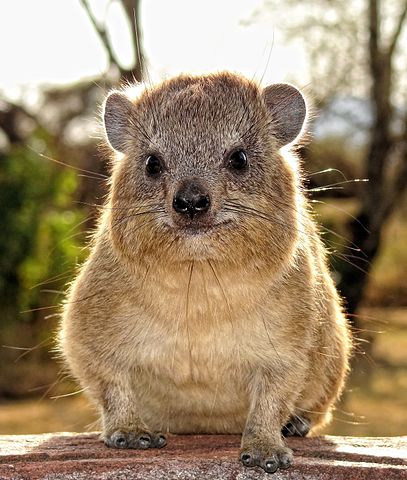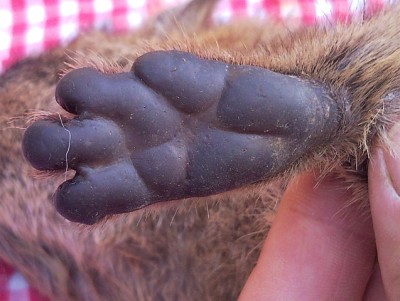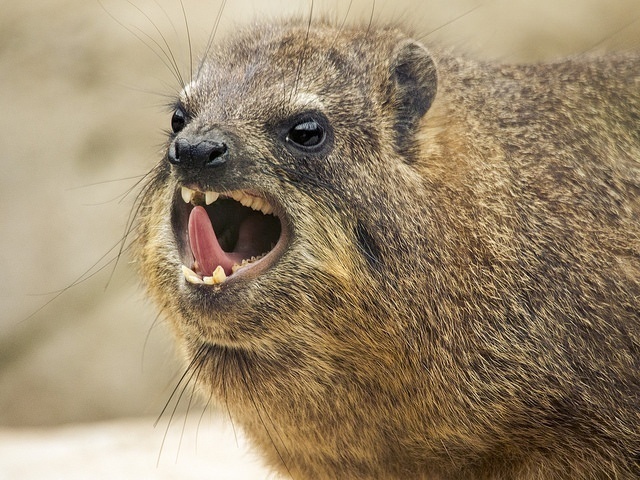The Rock Hyrax
Despite the size difference, the Rock Hyrax is the African elephant’s closest living relative, along with sea cows and manatees. These four mammals are unlike any other mammals and share a few disproportionate physiological similarities in teeth, leg and foot bones, and a few other details.

The rock hyrax is so unlike other animals that it is placed in a separate order (Hyracoidea) by itself.
Description
The rock hyrax, also called rock rabbit or dassie, is a small furry mammal that looks very much like a very big guinea pig. They have stumpy toes with hooflike nails, four toes on each front foot and three on each back foot. The longer, clawlike nails on the inside toes of the back feet are used for grooming and scratching. The bottoms of the feet have thick skin with a rubbery texture to assist in climbing steep rock surfaces and trees. The pads of the feet have glandular tissue which keeps the surface permanently moist to increase traction.

The rock hyrax is primarily found in East Africa. Its coat is yellowish or grayish-brown, and the dorsal spot (a bare scent gland on the back covered with longer hair) is covered with black or yellow hair. Its head is rounded and the nose is blunt. However, other rock hyraxes are known to have a more pointed, rodent-like nose. There is another species of hyrax called the tree hyrax which spends a lot of time in trees. In some areas, they are hunted for their thick, soft, long hair. The different species do not interact. Female hyraxes generally weigh 5 to 9 pounds (2.5 to 4.2 kg), and males are 7 to 10 pounds (3.2 to 4.7 kg. Both males and females grow to be about 22 inches (55 cm).
Habitat
Rock hyraxes are very adaptable. In East Africa, they live at sea level and up to altitudes of over 14,000 feet and in habitats ranging from dry savanna to dense rainforest to cold Afro-alpine moorland.
Behavior
Rock hyraxes live in colonies of about 50 in natural crevices of rocks or boulders. They regularly use “latrines” and in areas they inhabit, conspicuous white deposits from their urine form on rock faces. They are active in the daytime and like to bask in the sun on large rocks for long periods.
One dominant male will monopolize up to 17 females in a harem group. Solitary mature males live on the periphery of such harems.
What Does the Rock Hyrax Say?
Vocalizations include twitters, growls, whistles, and shrieks. One group will answer the contact calls of another group. The raucous nocturnal shriek of the tree hyrax is most impressive, starting as a squeak or whistle, then rising to a piglike squeal and finally to a child’s scream. Hyraxes do most of their screaming as they ascend or descend trees during the night.
Diet
The Rock Hyrax feeds on vegetation matter. It prefers grass when available during rainy seasons. During dry periods, it will eat whatever is available, even consuming highly toxic plants, which doesn’t seem to affect them. They will also feed on fruit, insects, lizards, and birds’ eggs They eat with the family group facing out from a circle to watch for signs of danger. If the territorial male gives the shrill shriek of alarm, the hyraxes either take cover or stay frozen on the spot, until the danger is gone. They can go a long time without water, getting adequate amounts of moisture from their food. Tree hyraxes feed on leaves and fruits.
Raising Young
The rock hyraxes have a gestation period of 7 months and give birth to two or three young during early summer. These young can run and jump about an hour after birth. They suckle until they are 3 months old, but they’ve already started eating by their second day. The young females in a family group often gather in a nursery group. The tree hyrax has fewer young (one or two at the most) than rock hyraxes, but they have many similar behavior traits, such as always defecating and urinating on the same spot.
Predators
Hyraxes are preyed upon by leopards, pythons, large birds, caracals, servals, and civets. They protect themselves from smaller predators by biting, but escaping to hiding places among the rocks is their best defense.

Did you know?
- Fossil remains indicate there were once hyraxes the size of oxen. This may explain its gestation period of 7 or 8 months, unusually long for an animal of its size.
- Rock hyraxes live in groups with one territorial male and up to 20 females and their young. Several groups may live in one area, but each male defends his territory from other males.
********
Rock Hyrax : Hyrax Closest Living Relative to the Elephant? Share on X
***************
I hope you have enjoyed, “Rock Hyrax: Hyrax Closest Living Relative to the Elephant?“
You might also like: Manatee Deaths Rising After Increased Dock Permitting
♥♥♥♥♥
MY QUESTION FOR YOU TODAY: Are there any animals you know of that you would like to see featured here on my blog? Is there any creature that you would like to learn more about? Or, do you have a story you would like to submit about a pet you have? I would love to hear from you in the comment section below, or please email me directly at jeanne@animalbliss.com
*************************
*** Please leave a comment below and remember to share. ***
It’s just sexy!
As always, thank you for taking the time to visit my blog!

♥ PEACE ♥
- Mindful Travel With Your Dog This Holiday Season - December 23, 2019
- A-Z of Australia’s Endangered Wildlife - December 20, 2019
- Teaching Your Kids How to Walk the Dog Safely - December 2, 2019

When I was a kid, I was a huge fan of the Wild Thornberrys, and there was an episode there about the rock hyrax which said it was the elephant’s closest living relative. I couldn’t believe something so small could be related to an elephant at all, let alone its closest living relative. That show was cool though because you learned a lot of fun animal facts while enjoying fictional stories at the same time. I always wished I had the power to talk to animals like Eliza. I still watch that show with my little man now. He loves it too!
Wow, you’ve come full circle. I have not heard of the Wild Thornberrys, so you must be living in a different country than I am. It sounds like a wonderful show. I’ll see if I can get a look at it online. It’s fun that you remember an episode about the hyrax. That’s wild. So glad that your little man enjoys the show now. There are a few childhood shows I used to love that I wish were still around to watch with my grandson. All the best to you and your little man, Amanda. Thank you for visiting and for sharing your story. Peace 🙂
That is a great pic of his toes. I must say thought that I like the last picture. He looks like he can take care of himself for sure. Those teeth are scary.
Yes, cute feet, aren’t they? I think they’re adorable. And yes, he sure does look like he can take care of himself well enough. At first my feelings were that this was a cute and cuddly animal, and I’m sure they can be. But when I saw that picture of the teeth, whoa! Wouldn’t want to get in a brawl with him! Thanks for stopping, Nate. I appreciate you. 🙂
That stare on the first photo melt me. So cute. Thank you for the information about Rock Hyrax. I wish they will be featured on an animated movie.
Thank you, Manu. I’ll get a video about them up sometime soon. 🙂